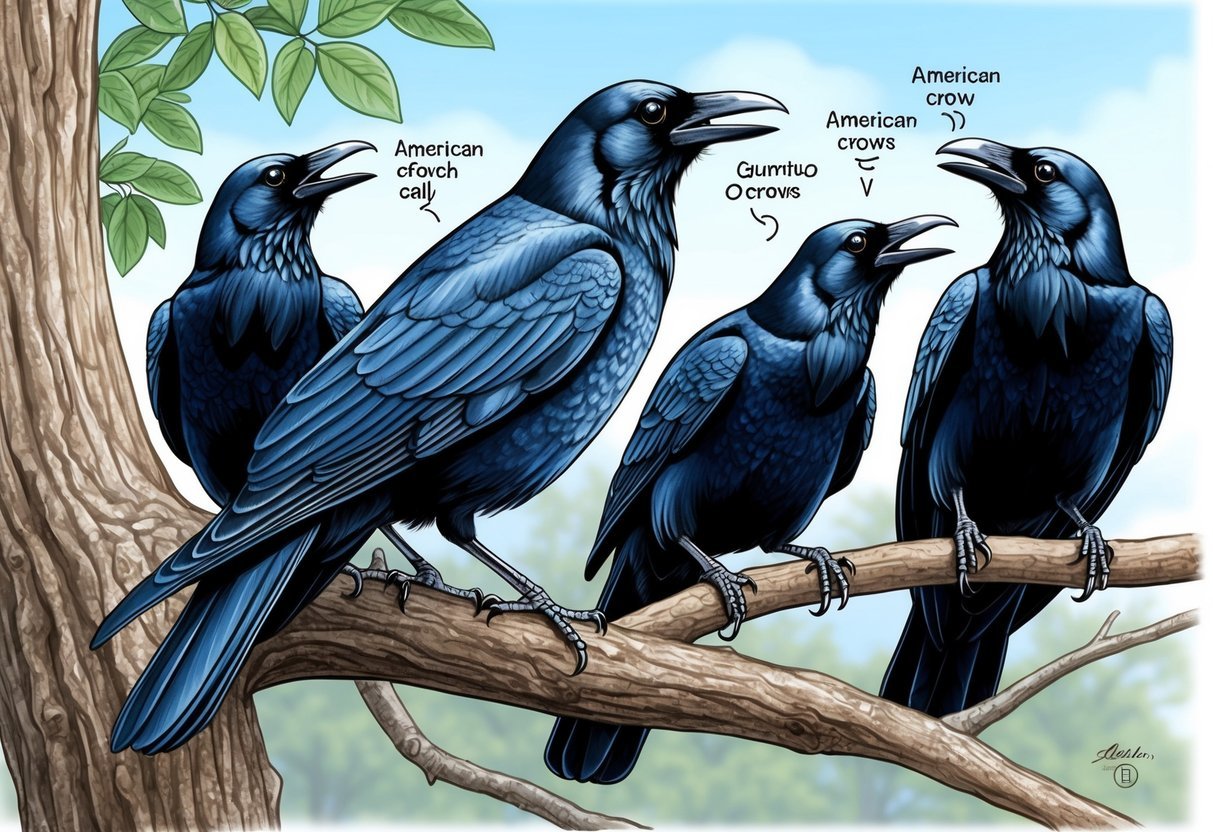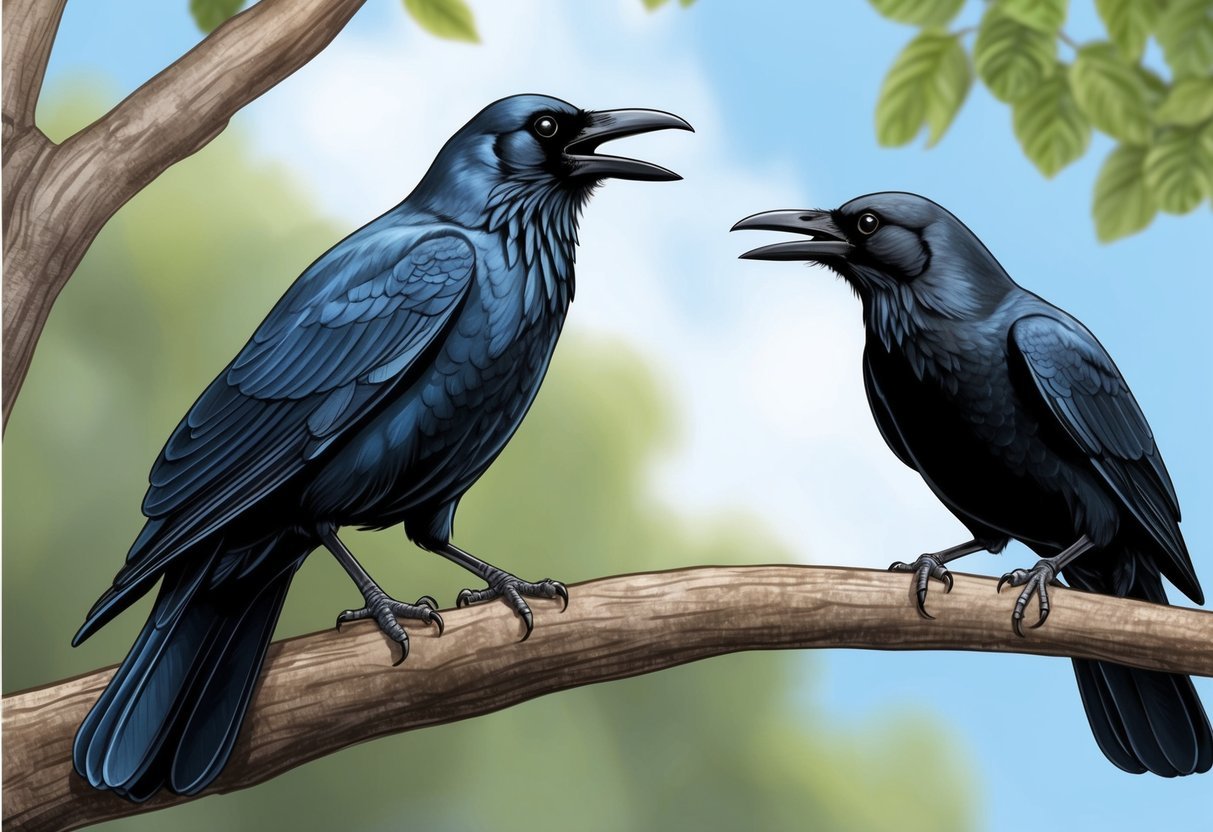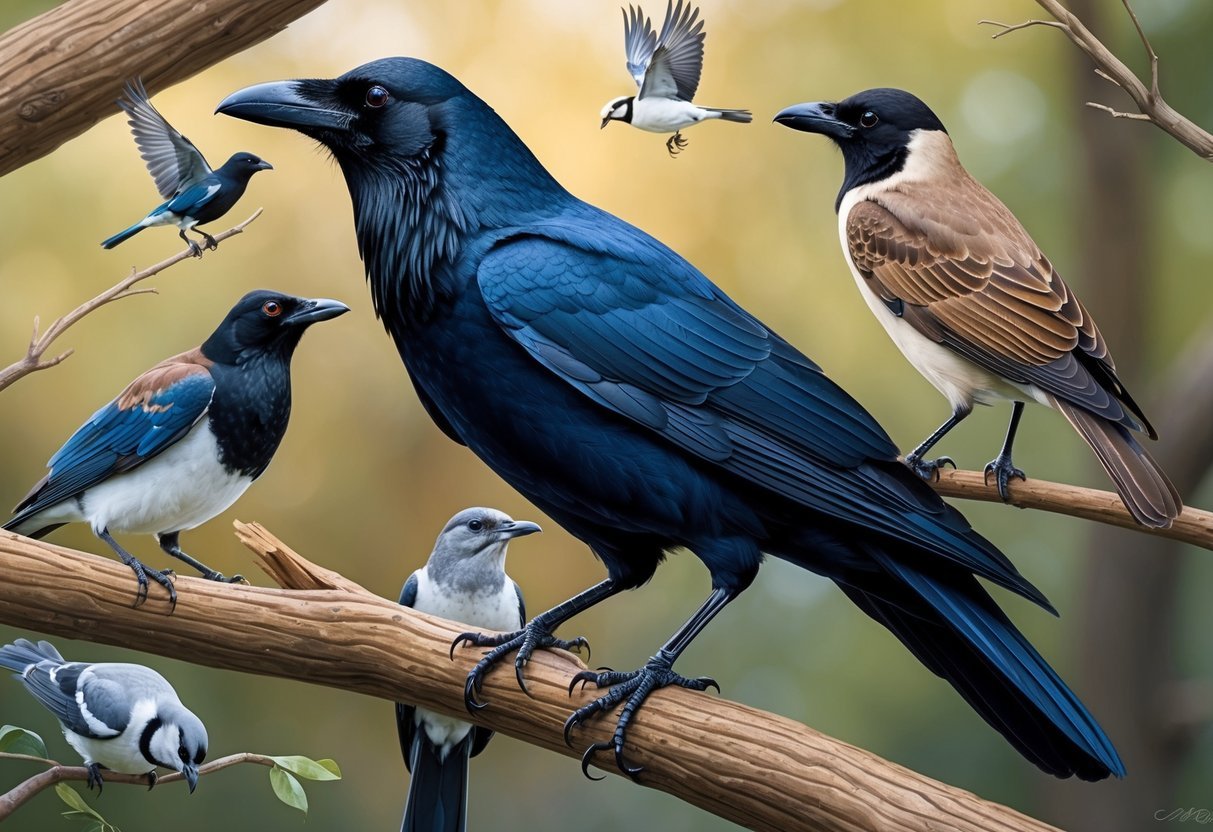The American crow is a fascinating bird that you might see every day without really noticing. These large, all-black birds are smart and adaptable. They live all over North America in many different places.
American crows have a distinct caw and can be found in cities, farms, and forests. They eat almost anything, from insects and seeds to small animals and even garbage. This ability to eat many foods helps them survive in lots of places.
Crows are known for being clever. They use tools, remember faces, and even hold funerals for their dead. They live in family groups and work together to find food and stay safe. Learning more about these birds can help us see how amazing they really are.
Species Overview
American Crows are smart, adaptable birds found across North America. They have a distinct look and voice that many people know. Let’s explore more about this common but fascinating species.
Taxonomy
The American Crow is known by its scientific name Corvus brachyrhynchos. It belongs to the family Corvidae, which includes ravens, jays, and magpies.
These birds are part of the genus Corvus, known for their intelligence. American Crows are closely related to other crow species found around the world.
They are different from ravens, though people often mix them up. Crows are smaller and have a different call.
Physical Characteristics
American Crows are big, all-black birds. They have thick beaks and can be up to 20 inches long. Their feathers have a glossy look that shines in the sun.
These crows have strong legs and feet. They use them to walk on the ground and grab food. Their wings are broad, helping them fly well.
Their most famous feature is their voice. Crows make a loud “caw” sound that’s easy to recognize. They use different calls to talk to each other.
Distribution and Habitat
American Crows live all over North America. You can find them in the United States and Canada. They’re in cities, farms, and forests from the Pacific Northwest to Florida.
These birds like many different places. They live in open woods, fields, and beaches. Crows also do well in towns and cities. They’re not picky and can make homes in lots of spots.
Crows often gather in big groups. They might move to warmer areas in winter, but many stay in the same place all year.
Diet and Feeding Behavior
American crows have a wide-ranging diet and clever feeding habits. They eat many different foods and use smart techniques to find their meals.
Foraging Habits
Crows are smart foragers. They look for food on the ground in fields, lawns, and along roads.
These birds will turn over rocks and dig in soil to find tasty treats. Crows also steal food from other animals and raid unprotected trash cans.
They work together to find food. Groups of crows will follow each other to good feeding spots. Sometimes they team up to chase away bigger birds from food sources.
Crows use tools too! They’ve been seen dropping nuts onto roads so cars will crack them open. Then the crows swoop down to eat the exposed nut meat when it’s safe.
Dietary Diversity
American crows eat almost anything. They love fruits like grapes and cherries. Seeds and nuts are big favorites too.
Crows munch on corn, wheat, and pecans. Insects make up a big part of their diet. They gobble up grasshoppers, beetles, and caterpillars. Crows also eat worms they find in the dirt.
These birds aren’t picky eaters. They’ll feast on:
- Small animals like mice and frogs
- Eggs from other birds’ nests
- Dead animals they find (carrion)
Crows even eat human food scraps when they can find them. Their varied diet helps them thrive in many different places.
Vocalizations and Sounds
American crows have a wide range of vocalizations and sounds. They use these to communicate with each other and express different emotions or situations.
Communication
Crows are highly intelligent birds with complex social lives. They use their voices to share information about food, dangers, and social interactions.
Their calls can warn others about predators or alert the group to a new food source. Crows also use body language alongside their vocalizations. They may ruffle their feathers, bob their heads, or flap their wings while making sounds. This helps them express themselves more clearly to other crows.
These smart birds can even mimic sounds they hear in their environment. Some crows have been known to copy human speech or other bird calls.
Crow Calls
The most well-known crow sound is the harsh “caw”. But crows have over 20 different calls in their repertoire. Each call serves a specific purpose.
The basic “caw” can vary in length and tone. Crows use it for general communication and to keep in touch with their group.
A series of rapid, loud caws often signals danger or aggression. Young crows make a high-pitched, nasal sound when begging for food. This call can sound similar to a Fish Crow’s voice.
Crows also produce softer sounds like rattles, coos, and honks. These gentler calls are often used between family members or during courtship.
Social Behavior

American crows have complex social lives. They form tight-knit groups and show remarkable smarts. These birds adapt well to different settings.
Flocks and Social Structure
American crows are very social birds. They often gather in large flocks, especially in winter. These flocks can have hundreds or even thousands of crows.
Crows also live in family groups. A typical family has two parents and kids from past years. The young crows help their parents raise new chicks. This teamwork makes crow families strong.
In their groups, crows have a pecking order. Some birds are bosses, while others follow. They use body language and calls to show who’s in charge.
Intelligence and Adaptation
Crows are super smart birds. They can solve puzzles and use tools. Some crows even make their own tools to get food. It’s like they’re tiny bird scientists!
These clever birds also learn from each other. Young crows watch their parents and copy what they do. This helps them learn important skills.
Crows adapt well to new places. You can find them in cities, farms, and forests. They eat all sorts of food and aren’t picky. This flexibility helps them thrive in many areas.
Reproduction and Nesting
American crows have unique breeding habits and build sturdy nests in various locations. Their reproductive cycle involves forming breeding pairs and raising young birds during spring and summer.
Breeding Habits
American crows typically form breeding pairs that stay together for many years. The breeding season starts in early spring and can last through summer. Crows are social birds, and young crows from previous years often help their parents raise new chicks.
Female crows lay 3-7 eggs per clutch. The eggs are about two inches long with a blue-green color and brown spots. Both parents take turns incubating the eggs for 17-20 days.
After hatching, the nestling phase lasts 33-43 days. During this time, the parents and helper crows work together to feed and protect the young birds.
Nesting Sites
Crows are adaptable when it comes to choosing nesting sites. They usually build their nests high up in trees, often 10-70 feet above the ground.
The nests are typically placed in a vertical fork or at the base of a branch against the trunk. Crow nests are large and bulky, measuring about 45 cm (1.5 ft) across and 18-25 cm (8-10 in) deep.
They construct their nests using small sticks, twigs, and bark strips. The birds line the inside with softer materials like grass, moss, and feathers for comfort.
In areas where twigs are scarce, crows may use long grass and plant stems instead. Occasionally, crows might nest on building ledges or rarely on the ground.
Predation and Defense
American crows face threats from various predators but have developed clever ways to protect themselves. They use their smarts and teamwork to stay safe in the wild.
Natural Predators
Owls and hawks are some of the main predators that hunt American crows. These birds of prey swoop down silently to catch crows off guard.
Large snakes can also be a danger, especially to crow eggs and chicks in the nest. Raccoons and cats may try to raid crow nests too.
Crows have to stay alert for these threats both day and night. They keep watch from high perches and warn each other if danger is near.
Defense Mechanisms
Crows are smart birds with many tricks to stay safe. They work together to chase away predators through a behavior called “mobbing.”
When a group of crows spots a threat, they gang up and make lots of noise. They dive-bomb the predator and try to peck at it. This teamwork often scares the predator away.
Crows can remember faces and will teach others about dangers. If a person or animal threatens them, they’ll remember and warn their friends.
Crows build their nests high up in trees to keep eggs and chicks safe. They take turns keeping watch while others look for food. This buddy system helps protect the whole group.
Human Interaction

American crows have a complex relationship with humans. They adapt well to urban environments and can impact agriculture in both positive and negative ways.
Urban Adaptation
Crows are smart birds that thrive in cities. They find clever ways to live alongside people. Crows use street lamps and tall buildings as perches. They eat food scraps from garbage cans and outdoor dining areas.
In city parks, crows scavenge for picnic leftovers. They also hunt small animals like mice and insects. Crows are not shy around people. They may approach humans for food in parks or campgrounds.
Crows recognize individual human faces. They remember people who have been kind or mean to them. This helps crows navigate human-filled spaces safely.
Agricultural Impact
On farms, crows can be both helpful and harmful. They eat crop-damaging insects and rodents, which helps farmers.
But crows also damage crops by eating seeds and fruit. They pull up newly planted corn and peck at ripening tomatoes. This behavior makes some farmers view crows as pests.
To manage crows, farmers use scare tactics. Loud noises, reflective tape, and fake predators can keep crows away. Some farmers provide alternative food sources to protect their crops.
Conservation efforts aim to balance crow populations with farming needs. This helps maintain ecosystem health while protecting food production.
Health and Conservation
American crows face health challenges and conservation issues. The birds are affected by diseases and have an uncertain conservation status that impacts their populations.
Disease Impact
West Nile Virus hit American crow populations hard. The virus first appeared in North America in 1999. Crows are very sensitive to this disease. Many died when it spread.
The virus affected crow numbers in some areas. Scientists use dead crows to track West Nile Virus. They test the birds to see where the virus is active.
Crows can also get other illnesses. But West Nile Virus had the biggest effect on their health. The good news is that some crows seem to be getting more resistant to the virus over time.
Conservation Status
American crows are not endangered right now. They adapt well to different places, so you can find them in cities, farms, and forests.
The Migratory Bird Treaty Act protects American crows. This law makes it illegal to harm them without permission. Some states do allow crow hunting though.
Crows face some threats, such as people who see them as pests. This can lead to conflicts. Loss of habitat is another problem for crows in some areas.
Despite these issues, crow numbers are stable overall. They’re smart and flexible birds, which helps them survive in changing environments.
Comparative Analysis

American Crows share similarities with several other corvid species. Key differences in size, vocalizations, and behavior help distinguish them from their close relatives.
Similar Species
American Crows are often confused with other black birds. The Common Raven is larger and has a heavier bill. Fish Crows are slightly smaller with a higher-pitched call. Northwestern Crows look very similar but have a more limited range.
Blue Jays are smaller and have blue feathers. Magpies have long tails and white patches. Carrion Crows and Hooded Crows are found in Europe and Asia, not North America.
Distinguishing Features
Size helps tell American Crows apart. They’re bigger than Fish Crows but smaller than ravens. Their caw is lower-pitched than Fish Crows. American Crows have square-tipped tails, while ravens have wedge-shaped tails.
Behavior also differs. American Crows are more social and often seen in groups. Ravens are usually solitary or in pairs. American Crows are more common in urban areas, while ravens prefer wilder habitats.
Beak shape varies too. American Crows have straighter beaks, while ravens have curved beaks. Wing feathers look different in flight as well. Crows’ wings are more rounded, while ravens have longer, finger-like feathers.
Cultural Significance
The American crow holds a special place in many cultures. These smart birds have captured people’s imagination for centuries.
In Native American traditions, crows are often seen as sacred messengers. They’re believed to carry important news between the spirit world and our own.
Some tribes view crows as symbols of wisdom and intelligence. This isn’t surprising, given how clever these birds can be!
Crows also play a role in folklore around the world. In some stories, they’re tricksters who outsmart other animals. In others, they’re guides helping lost travelers find their way.
The Corvidae family, which includes crows, has inspired many myths and legends. People have long been fascinated by their problem-solving skills and social behavior.
In literature and art, crows often represent mystery or magic. Their dark feathers and piercing calls make them perfect for spooky stories!
But it’s not all serious. Crows can be funny too! Many people enjoy watching their playful antics and listening to their varied calls.
Today, crows continue to inspire artists, writers, and nature lovers. Their adaptability in urban areas has brought them closer to humans than ever before.

